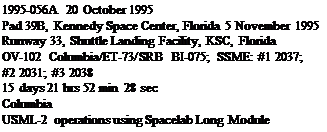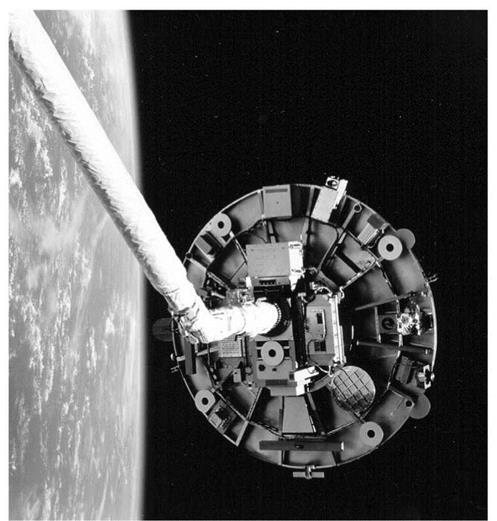STS-69
 1995-048A 7 September, 1995
1995-048A 7 September, 1995
Pad 39A, Kennedy Space Center, Florida 18 September 1995
Runway 33, Shuttle Landing Facility, KSC, Florida
OV-105 Endeavour/ET-72/SRB BI-074/SSME #1 2035;
#2 2109; #3 2029
10 days 20hrs 28 min 56 sec
Endeavour
Wake Shield Facility-2 operations; SPARTAN 201-03 operations; EVA Development Flight Test
Flight Crew
WALKER, David Mathiesen, 51, USN, commander, 4th mission Previous missions: STS 51-A (1984); STS-30 (1989); STS-53 (1992) COCKRELL, Kenneth Dale, 45, civilian, pilot, 2nd mission Previous mission: STS-56 (1993)
VOSS, James Shelton, US Army, mission specialist 1, payload commander, 3rd mission
Previous missions: STS-44 (1991); STS-53 (1992)
NEWMAN, James Hansen, 38, civilian, mission specialist 3, 2nd mission Previous mission: STS-51 (1993)
GERNHARDT, Michael Landen, 39, civilian, mission specialist 4
Flight Log
Set originally for 5 August, the launch of STS-69 was postponed indefinitely pending a full review of the SRM nozzle damage found on the two previous missions. This problem was found to be caused by the Room Temperature Vulcanising (RTV) process when insulation material was applied; small air pockets in the material could later form pathways for the hot gases during motor operation. The joint design was deemed to be sound and non-destructive inspections were developed to examine the insulation material on specific joints. Development, testing and application of the repair procedures was conducted, and these could be performed on STS-69 while it was still on the pad, alleviating the need for a rollback. The nozzles on the motors assigned to STS-73 and 74 were repaired at KSC but these did not impact upon processing schedules. The planned 31 August launch of STS-69 was scrubbed about 5.5 hours prior to lift-off when Fuel Cell 2 indicated higher than allowed temperatures during activation. It was removed and replaced, and the launch was rescheduled for 7 September.
|
The Wake Shield Facility is attached to the RMS during its second of four planned flights on the Shuttle |
The deployment of the SPARTAN-201 occurred during FD 2 and was the third of a series of four flights of the facility. SPARTAN-201 was designed to study the outer atmosphere of our Sun and its transition into the solar wind that constantly flows past the Earth. At the same time as SPARTAN was being operated, the Ulysses space craft (deployed from STS-41 in October 1990) was flying over the Sun’s northern polar regions, obtaining data that would expand our understanding of solar wind from different regions of the Sun. Concerns about the performance of the two onboard instruments were raised after two days of gathering data, but subsequent analysis revealed that both instruments had operated normally and had gathered the expected
amounts of data. The question of why the SPARTAN was rotating and in a different attitude for retrieval than expected would require further analyses.
The second flight of the Wake Shield Facility featured another first. Released on FD 5, the WSF manoeuvred away from Endeavour instead of the other way around, as on previous deployments. Seven thin film growths for the next generation of advanced electronics were planned during the mission, but after only three successful growths, the facility placed itself in safe mode. It was decided to extend the facility’s free-flight by 24 hours to allow a 20-hour break in operations while still achieving seven growths of material. However, when controllers commanded the resumption of operations, they could not generate the flow of the thin material, so the facility was shut down again for a six-hour cool-down period. This time it started up correctly and a fourth film was grown, before the facility was finally retrieved on FD 8. The WSF-2 was deployed on the RMS and placed over the side of the cargo bay for an Air Force experiment designed to collect data on the build-up of electrical fields around orbiting spacecraft.
In addition to the range of medical and secondary payloads in the payload bay, the crew also completed the second in the series of EVA development tests aimed at providing experience and developing procedures applicable to ISS. On FD 10, Voss (EV1) and Gerhardt (EV2) completed their 6 hour 46 minute EVA, where they evaluated improvements in the thermal protection of the EMUs (as a result of the crew’s experiences during the STS-63 EVA earlier in the year) and reported improved comfort levels. Improvements included finger tip heaters in the gloves, which were powered by 3.7 volt lithium batteries. Sensors on their EMU boots and on the PLSS backpacks also recorded exterior temperatures. In between activities at a tool board, each astronaut was “cold-soaked” 9 metres above the payload bay on the RMS for 45 minutes while they completed repetitive tool-handling exercises. The two astronauts also evaluated a range of new EMU helmet lights, tools restraints and techniques that were being developed for possible use in construction missions at ISS. They took turns in removing micrometeoroid/debris shields from a work board, tested power tools, and manipulated items such as an antenna, an orbital replacement unit box and electrical conduits, both while restrained and “free-floating’’.
This mission was also the second flight of a “dog crew’’, a tradition begun on STS-53, which included both Walker and Voss among the crew. Dog crew call signs originated from Walker who, due to his red hair, was called “Red Dog’’. His old station wagon was also known as the “dog mobile’’ and was the impetus for “dog tag’’ names for his crew members. Dog Crew II thus became: Red Dog (Walker), Cujo (Cockrell); Dog Face (Voss); Pluto (Newman) and Under Dog (Gerhardt).
Milestones
182nd manned space flight 101st US manned space flight 71st Shuttle mission
9th flight of Endeavour
32nd US and 59th flight with EVA operations
2nd flight of Wake Shield Facility
3rd flight of SPARTAN 201 facility
1st Shuttle mission featuring deployment and retrieval of two different payloads on the same mission 2nd EDFT exercise

 |
Flight Crew
BOWERSOX, Kenneth Duane, 38, USN, commander, 3rd mission Previous missions: STS-50 (1992); STS-61 (1993)
ROMINGER, Kent Vernon, 39, USN, pilot
COLEMAN, Catherine Grace “Cady”, 34, USAF, mission specialist 1 LOPEZ-ALEGRIA, Michael Eladio, 37, USN, mission specialist 2 THORNTON, Kathryn Cordell Ryan, 43, civilian, mission specialist 3, payload commander, 4th mission
Previous missions: STS-33 (1989); STS-49 (1992); STS-61 (1993)
LESLIE, Fred Weldon, 43, civilian, payload specialist 1 SACCO Jr., Albert, 46, civilian, payload specialist 2
Flight Log
Getting STS-73 back on the ground after a highly successful USML-2 mission was achieved at the first attempt. Getting the mission off the ground in the first place, however, had proven a littlemore frustrating, equalling STS 61-C (12-18 Jan 1986) for the most launch scrubs. Shortly after tanking began for the 25 September launch, a leak in the SSME # 1 main fuel valve caused the first scrub. The reset 5 October launch was postponed a day due to the effects of Hurricane Opal and the 6 October attempt was scrubbed when hydraulic fluid was inadvertently drained from hydraulic system 1 after the SSME # 1 fuel valve replacement. Reset again to 7 October, the launch was scrubbed once more, this time due to a faulty Main Events Controller that required replacement. The 14 October launch was rescheduled for the following day to allow additional time to inspect the SSME oxidiser ducts on Columbia, as a result of cracks found in a test engine at Stennis. A faulty GPC was also replaced. The 15 October attempt was scrubbed at T — 5 minutes because of low clouds and rain and the launch was reset for 19 October, pending a successful Atlas launch on 18 October. However, the Atlas launch was delayed, forcing the STS-73 launch to be rescheduled once more,
|
Payload commander Thornton and commander Bowersox observe liquid drop activity at the Drop Physics Module in the Spacelab science laboratory aboard Columbia, as part of the USML-2 mission |
for 20 October. Even that countdown was delayed 3 minutes, due to a range computer glitch.
When Columbia finally made it to orbit, the crew built upon the success of USML-1 (on which Bowersox was a crew member) with many of the experiments flying a second time. The astronauts worked in two shifts. The Red Shift consisted of Bowersox, Thornton, Rominger and Sacco. The Blue Shift comprised Lopez-Alegria, Coleman and Leslie. There were five areas of research conducted on the mission: fluid physics; materials science; biotechnology; combustion science; and commercial space processing. Generally the experiments performed well, and many re-confirmed findings recorded during USML-1, while the flight also recorded new and unique findings confirming the decision to fly a second USML mission. Flying for the first time was a droplet combustion experiment in which 25 droplets of a variety of fuels were ignited. The studies revealed that larger droplets could be observed in microgravity than on Earth and they burned ten times longer in space. Results from Astroculture experiments indicated that edible food could be grown in a plant growth facility, which has enormous potential for future applications on larger space facilities, deep space missions or future bases on the Moon or Mars. A record number of protein crystal growth samples (approximately 1,500) were flown on this mission. Apart from their Spacelab work the crew taped a ceremonial first pitch for game five of the Baseball World Series, which marked the first time in baseball history that the thrower was not actually in the ballpark for the pitch.
Milestones
183rd manned space flight
102nd US manned space flight
72nd Shuttle mission
18th flight of Columbia
2nd flight of USML series
12th flight of Spacelab Long Module
6th EDO mission












